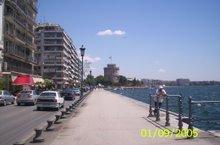CONSTANTINO BRUMIDI: BIOGRAPHY
Constantino Brumidi painted scores of frescoes in the United States Capitol. In addition to "The Apotheosis of George Washington" which appears in the Capitol dome in the Rotunda, Brumidi created artworks in the House of Representatives Chamber, many committee rooms, the President's Room, the Senate Reception Room, and throughout the corridors of the Capitol. One cannot tour the United States Capitol without being inundated with the work of Brumidi. The West Corridor of the Capitol has been termed the "Brumidi Corridor." The influence of Constantino Brumidi's artistic sensibilities on the artwork of the nation's Capitol are undisputed, but definitive and scholarly treatments of Brumidi's life and work are less evident.
Constantino Brumidi was born in Italy in 1805. He grew up in Rome, and studied at the Italian Academy of Arts. He showed his talent for fresco painting at an early age and painted in several Roman palaces, among them being that of Prince Torlonia. Under Gregory XVI he worked for three years in the Vatican. The occupation of Rome by the French in l849 apparently decided Brumidi to emigrate, and he sailed for the United States, where he became naturalized in 1852. Taking up his residence in New York City the artist painted a number of portraits. Subsequently he undertook more important works, the principal being a fresco of the Crucifixion in St. Stephen's Church, for which he also executed a "Martyrdom of St. Stephen" and an "Assumption of the Virgin".
In 1854 Brumidi went to the city of Mexico, where he painted in the cathedral as allegorical representation of the Holy Trinity. On his way back to New York he stopped at Washington and visited the Capitol. Impressed with the opportunity for decoration presented by its vast interior wall spaces, he offered his services for that purpose to Quartermaster- General Meigs. This offer was accepted, and about the same time he was commissioned as a captain of cavalry. His first art work in the Capitol was in the room of the House Cornmittee on Agriculture. At first he received eight dollars a day, which Jefferson Davis, then Secretary of War of the United States, caused to be increased to ten dollars. His work attracting much favourable attention, he was given further commisssons, and gradually settled into the position of a Government painter.
Brumidi was a capable, if conventional painter, and his black and white modelling in the work at Washington, in imitation of bas-relief, is strikingly effective.
Brumidi devoted his time to numerous commissioned frescoes, paintings, and sculpture in the Capitol building. The only known quote from Brumidi has been preserved by American author Smith Fry, who asserts that upon reaching America Brumidi said:
"I have no longer any desire for fame and fortune. My one ambition and my daily prayer is that I may live long enough to make beautiful the Capitol of the one country on earth in which there is liberty".
This quote may be inauthentic. Mr. Fry, the author of "Thrilling Story of the Wonderful Capitol Building and Its Marvelous Contents" (1911) and "Fry's Patriotic Story of the Capitol" (1911), provides no documentation.
In 1860, Brumidi married an American woman named Lola Germon.
There is no information on his first (Italian) marriage, but he did keep in contact with a daughter, Elena, who remained in Rome.
On February 18, 1880, Constantino Brumidi died at his home in Washington, D.C. Brumidi died in relative penury, but Congressional records indicate that he was well-paid. Originally, his salary was pegged to the annual salaries awarded to United States Congressmen, but this was eventually changed to a per diem ranging from eight to ten dollars. The largest work commissioned, "The Apotheosis of George Washington," was contracted for a lump sum of $40,000. Brumidi received all but the $500 reserved for completion of the project.
Brumidi's reputation waxed and waned, both during and after his lifetime. For almost one hundred years after his death, his grave in Washington was unmarked and unadorned. Little notice was made of the artist of the Capitol frescoes. The public's limited awareness of the existence of Brumidi was expanded by a conscious resurrection of his reputation in the 1950's by Myrtle Cheney Murdock.
In 1966 the U.S. Congress authorized the creation of a portrait bust honoring Constantino Brumidi that would be displayed in the Brumidi Corridors. The legislation was spurred in part by renewed appreciation of Brumidi following publication of a biography on him written by Myrtle Cheney Murdock, the wife of an Arizona congressman. Sculptor JIMILU mason was awarded the commission in early 1967; she based her likeness of Brumidi on photographs taken during his life. The Joint Committee approved the plaster model, and the image was translated into Carrara marble in Pietrasanta, Italy. JIMILU's bust of Brumidi was unveiled in the Capitol Rotunda in 1968 at dedication ceremonies attended by Congressional leaders and the ambassadors of Italy and Greece.
Tag Cloud
2007-03-25
CONSTANTINO BRUMIDI: BIOGRAPHY
Posted by
Αντωνης Βαλαμoντες
at
10:03 AM
![]()
Labels: greek artists, greek culture in america, greek painters
Subscribe to:
Post Comments (Atom)
My Headlines




No comments:
Post a Comment